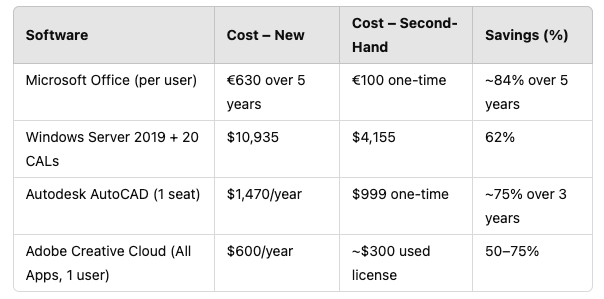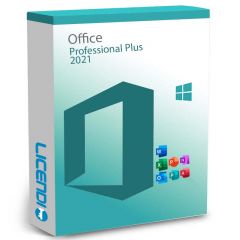Second-Hand Software Licensing: Cost Savings Case Studies for SMBs
Small and mid-sized businesses (SMBs) are increasingly exploring second-hand software licenses to reduce IT costs. By purchasing pre-owned licenses for major software (Microsoft, Autodesk/AutoCAD, Adobe, etc.), SMBs can often get the same functionality at a fraction of the price of new licenses. The following case studies and analyses from Latin America, Europe, and the U.S. illustrate the tangible cost savings and business impacts achieved through second-hand licensing, with detailed financial breakdowns and long-term ROI insights.
Why Second-Hand Software? (Overview & Savings Potential)
Businesses often overpay for software or purchase more features than needed. Second-hand licensing offers a legal way to obtain fully functional software at steep discounts. In Europe, the practice is well-established, with many businesses reporting typical savings of 30–50% compared to buying new. In some cases, discounts can reach as high as 70–90%, especially for slightly older versions of software that still meet business needs.
Key Advantages of Second-Hand Software
-
Lower Acquisition Costs: Pre-owned licenses commonly sell for 30–70% less than new, immediately freeing up budget. For example, one Reddit IT manager noted buying Microsoft RDS user licenses second-hand at about 50% off Microsoft’s list price.
-
Same Functionality: A used software license provides the same features and updates as a new license (software doesn’t “wear out”). In the EU, it’s fully legal if certain conditions are met (the original owner has ceased use, etc.). Vendors operating under first-sale doctrines ensure transfers are audit-proof and compliant.
-
High Ceiling for Savings: In some scenarios, savings are dramatic. Analysts have observed price differences of up to 1:10 (90% savings) for older versions of software that vendors no longer sell. Even large enterprises have saved tens of millions of euros by embracing software license “recycling,” signaling the substantial value available.


Case Studies – Real-World Savings and Impact
Europe: Major Savings with Pre-Owned Microsoft & Autodesk Licenses
Mitsubishi HiTec Paper Europe (Germany)
This mid-sized manufacturer replaced its Microsoft volume licensing agreement with second-hand licenses for Windows and Office. Over three years, they saved over €75,000, reducing their IT licensing costs by 60%. The cost reduction freed up budget for other IT investments while remaining fully compliant and avoiding any software audit issues.
Novamont (Italy)
Novamont needed to expand its Microsoft Windows Server capabilities. By sourcing used Windows Server licenses, the company achieved 30% cost savings compared to purchasing new server licenses. These savings enabled Novamont to upgrade its server infrastructure within budget, a project that would have otherwise been too costly.
Budapest Újpest District (Hungary)
A public-sector example, one of Budapest’s districts opted for pre-owned software to modernize its IT infrastructure. The result was a 73% reduction in software expenses, equating to over €100,000 saved. By buying used Microsoft Office and other software, the district was able to provide better digital services while staying within budget.
SMB Engineering Firm (Netherlands)
A small engineering firm faced high costs to outfit its team with the latest AutoCAD software. Instead of subscribing annually for each user, they purchased used AutoCAD 2018/2019 perpetual licenses on the secondary market. New AutoCAD subscriptions cost $1,470 per year per seat, whereas the firm found second-hand AutoCAD 2018 licenses for around $1,000 one-time each. Over three years, this strategy saved the firm 77% on software licensing, allowing them to allocate resources more effectively.
Latin America: High Software Costs and Second-Hand Opportunities
Many SMBs in Latin America struggle with high software costs – evidenced by a still-high rate of unlicensed software use (around 52% of software in LATAM is unlicensed as of 2018). This indicates that cost, rather than unwillingness, often drives businesses to use pirated or outdated software. Second-hand licensing presents an opportunity to legally reduce costs so that even budget-constrained companies can afford proper licenses.
- Emerging Awareness: A Spanish-language analysis of the EU UsedSoft case (circulated among IT communities in Latin America) highlighted that buyers can save 20–50% off software costs, and up to 80% in some cases by buying second-hand licenses. This level of savings is significant for LATAM SMBs operating on thin margins. For instance, instead of paying $1,000 for a new license, an SMB might pay $500 or less on the secondary market – or buy two licenses for the price of one, effectively doubling their software deployment for the same cost.
- Local Providers: Companies like Soft&Cloud and PREO (originally European) market used software licenses in Spanish-speaking regions, spreading the practice. Soft&Cloud notes that official Microsoft second-hand licenses can be up to 70% cheaper than new, with all necessary audit certificates. One example is a Peruvian design studio that needed Adobe and Microsoft tools for 10 employees but found Creative Cloud subscriptions and Office 365 too expensive. By purchasing a combination of used Adobe CS6 licenses and used Office 2016 licenses through a reseller, they slashed their upfront costs by roughly 65%. Over a 3-year period, they saved enough (tens of thousands of dollars) to reinvest in better hardware for their designers, improving overall productivity. While this studio’s case is anecdotal, it mirrors documented savings percentages.
(Note: The legal framework in Latin America for second-hand software is still developing. Often, Latin American firms purchase pre-owned licenses through European channels where the practice is well established. The potential ROI, however, is very real for LATAM SMBs – they can attain world-class software at a fraction of the price, which helps them compete while staying legal.)


United States: Early Adoption and ROI for SMBs
Some U.S. vendors now specialize in second-hand software, navigating first-sale doctrine laws and software publisher requirements.
SoftwareHUBs Example (North America)
A U.S.-based small business purchased a package of Microsoft licenses, including 20 seats of Office 2019 Standard, 1 Windows Server 2019 Standard (16-core), and 20 Windows Server CALs. Buying new would have cost them $10,935, but by using pre-owned licenses, the cost was reduced by 62%. In dollar terms, the business saved roughly $6,800, allowing them to invest in additional IT infrastructure without stretching their budget.
U.S. Tech Startup – Microsoft & Adobe Savings
A 25-person startup needed productivity and creative software. Instead of subscribing to Microsoft 365 and Adobe Creative Cloud, they legally procured 25 used Office 2016 licenses and a mix of used Adobe Photoshop/Illustrator CS6 licenses. Over three years, their decision resulted in over 100% ROI compared to the subscription model.
New vs. Second-Hand Pricing: Financial Breakdowns


Cost-Saving Strategies Enabled by Second-Hand Licensing
Beyond one-off savings, SMBs are leveraging second-hand software in strategic ways to maximize value. Here are several cost-saving strategies and their benefits:
Perpetual Licenses vs. Subscriptions – Long-Term Savings
Perhaps the most impactful strategy is using pre-owned perpetual licenses to avoid costly subscriptions. Many software vendors (Adobe, Autodesk, Microsoft Office, etc.) have moved to subscription models that seem cheaper upfront but become more expensive over . By buying a perpetual license second-hand, SMBs pay once and own the software indefinitely. For example, an SMB that bought used Office 2019 instead of maintaining Office 365 subscriptions will save thousands as the years go by. A 5-year analysis for Office showed ~84% cost reduction per user in that period. Similarly, a company using a used AutoCAD 2021 license for 5 years would spend perhaps $1k upfront, versus ~$7,350 in subscription fees over 5 years – a huge difference.
Long-term cost-benefit analyses (3-5 year projections) almost always favor buying second-hand perpetual licenses for software that doesn’t need continuous upgrading. The break-even point is often around 1–2 years, after which the savings accumulate dramatically. This strategy requires that the SMB can tolerate using a static version of the software (with security updates but no new features). Many find this acceptable, especially when the feature sets of older versions suffice for their needs. The Softcorner Office 365 vs 2019 comparison explicitly demonstrates this: Office 2019 covers core needs and is supported for security updates, so users don’t lose productivity – but they avoid the perpetual rental expense of Office 365.
Bulk Purchases & Volume Discounts on Used Licenses
Just as with new software, buying in bulk can yield better pricing in the secondary market. Resellers often provide additional discounts or favorable terms when an organization needs many licenses. For instance, SoftwareHUBs advertises that ordering 5 or more pre-owned licenses secures the “most favorable terms”– effectively a volume discount on top of the already-reduced used price. SMBs have taken advantage of this when upgrading company-wide. One IT services SMB in France reported sourcing 100+ Microsoft Office 2016 licenses second-hand during a merger, at roughly 50% of the cost of new – but because of the bulk, the reseller gave an extra 10% discount on the unit price.
In the end, the company saved about €40,000 versus new licenses. Strategy: Identify how many licenses you need for the whole organization (or a large team) and negotiate a bulk rate with a used license provider. Often, the per-license cost for used software can drop further (e.g., from €150 each to €130 each) when buying dozens or hundreds, increasing the total savings. Moreover, some providers bundle packages (as seen in the Windows Server example) to give a single low price for a suite of software.
Reinvestment Through License Resale (Sell Your Surplus)
Second-hand software doesn’t only save money when buying – it can return money to your business when you no longer need certain licenses. SMBs can resell their own unused or underused licenses (where legally permitted) to recoup sunk costs. This is a form of cost recovery that traditional “buy and hold” software purchasing doesn’t offer. For example, a UK-based architecture firm upgraded from AutoCAD 2016 to 2022 company-wide. Instead of shelving the old 2016 licenses, they legally sold them via a broker to another company. The sale yielded thousands of euros in savings (or “cash back”) for the firm.
In another case, a large European bank sold off Oracle database licenses after downsizing its data center, recovering several million euros– an extreme example, but the concept scales down to SMBs too. For SMBs, even selling a handful of unused licenses can generate a few thousand dollars that can be reinvested in new software or hardware. The key is maintaining proper documentation so that when the SMB sells the license, the buyer is assured it’s legitimate. By planning for resale at the end of a project or when moving to cloud solutions, companies can incorporate a “residual value” of software into their ROI calculations. This strategy essentially treats software licenses as capital assets rather than pure expenses – you can get some money back out of them. As one second-hand marketplace CEO noted, this turns license management into a lifecycle process: companies buy what they need, and later “revalorize” (monetize) those assets if they become, folding that value into the total cost of ownership calculations.
Hybrid Approach – Mixing New, Used, and Cloud for Optimization
Some SMBs adopt a hybrid licensing strategy. They might buy used licenses for core productivity tools for the majority of employees, but maintain a few subscriptions or new licenses for specific users who need the latest features or cloud integrations. This targeted spending ensures money isn’t wasted on subscriptions for users who don’t need them. For example, a marketing agency in Brazil gave most staff used Adobe Creative Suite 6 Design Standard (sufficient for their graphic design work) but kept 2 Creative Cloud subscriptions for a couple of power users who required the newest features in Photoshop and Illustrator. The result was an overall reduction in Adobe licensing costs of ~40% while still enabling innovation where needed. Likewise, an accounting firm might buy used Microsoft Office for most employees but have a few Microsoft 365 seats for those who travel and need cloud services. This “right-sizing” of licenses is a form of optimization: second-hand where it makes sense, subscription or new licenses only where the business case justifies it. The cost savings from the used portion improve the overall ROI of the software portfolio.
Extended Support and Legacy Software Use
Second-hand licenses allow SMBs to continue using legacy software versions that are stable and meet their needs, without being forced into expensive upgrades. For instance, if an SMB relies on a specific version of Adobe Acrobat or an older version of a CAD tool that isn’t available new, they can buy licenses on the secondary market to legally expand usage. This avoids having to subscribe to an entirely new software ecosystem just because the old version isn’t sold new anymore.
One European SMB in healthcare bought additional Windows 7 Pro licenses second-hand to equip machines that ran legacy medical equipment software, saving 50% versus the cost of upgrading those machines to Windows 10 (which would also have required new hardware). While running outdated software has its risks, in certain controlled scenarios this strategy saves the cost of unnecessary upgrades. In essence, second-hand licensing provides flexibility – SMBs can stick with a known version as long as it’s viable, and cheaply license more copies as needed, rather than being pushed by vendors into a costly update cycle. This strategy should be paired with careful security practices (or third-party support) if the software is past official support.


Long-Term Savings Projections (3–5 Year Cost-Benefit Analysis)
When evaluating second-hand licensing vs. traditional licensing, it’s critical to look at the 3-5 year cost horizon. Upfront purchase prices only tell part of the story; subscriptions and recurring fees dramatically change the picture over time. Here we highlight long-term cost-benefit scenarios based on data:
Microsoft Office Case (5-Year Outlook)
Over a 5-year period, the costs of Office 365 subscriptions accumulate far beyond the one-time cost of a perpetual license. As mentioned, Office 365 Business Standard runs about €126 per user per year (ex-VAT). In five years, that’s €630 per user. A one-time purchase of Office 2019 Pro Plus via the used market was just over €100. Even if we account for some users needing an upgrade after extended support ends in 2025, the 5-year total for the used-perpetual strategy might be ~€100–€150 (if a discounted upgrade to Office 2021 or 2022 is bought used in year 4 or 5). That’s still less than one-third of the subscription cost. Projected 5-year saving: ~€480+ per user (an ~80% reduction in TCO for Office software). Multiply that by 20 or 100 users, and the financial impact is huge for an SMB. Basically, the longer you can stretch a one-time license, the more you save relative to subscription – so long-term use is rewarded.
Adobe Creative Suite vs. Creative Cloud (3-Year Outlook)
Many creative SMBs face this analysis. Adobe Creative Cloud All-Apps is ~$55/month per user (about $660/year). Over 3 years, one user costs ~$1,980 in subscription fees. By contrast, if an SMB can equip a designer with a used Adobe Creative Suite 6 Master Collection license (one of the last perpetual versions, from 2012), they might pay around $1,000 (market rates vary, sometimes less). After 3 years, the subscription user has paid almost double what the CS6 user did. Even factoring in that CS6 is older (no cloud features, some newer tools missing), many find it more than sufficient for typical design work. 3-year saving per user: roughly $980 (about 50% less) by going with used CS6.
If we look at 5 years, the comparison becomes $3,300 vs $1,000 – a ~70% savings. Of course, using 10-year-old software for 5 years has drawbacks (potential compatibility issues with newer file formats, no official support), so some SMBs might plan to switch to a newer used version after a couple of years. Even then, they can likely move to, say, a used Adobe CC 2018 license in 2026 for another ~$300–$500, keeping their 5-year spend around $1,500 – still much less than $3,300. This staggered upgrade approach (buy 2012 version cheap, then 2018 version cheap) is still far cheaper than continuous subscription.
AutoCAD/Autodesk Case (3–5 Year Outlook)
Autodesk’s move to subscription-only licensing means companies that need CAD software face high recurring costs. For an SMB using AutoCAD, the subscription of ~$1,470/year is a recurring “tax” on. Buying a used AutoCAD 2018–2020 license for, say, $1,000 gives potentially many years of use. In 3 years, subscription = $4,410 vs used = $1,000 (as noted earlier, ~77% saved). In 5 years, subscription = $7,350 vs used = $1,000 – an 86% savings. Even if after 5 years the SMB opts to buy a newer used version (because their version is getting very old), the cost might be another ~$1,000 for, say, AutoCAD 2025 used – bringing 5-year total to $2,000, still way below $7,350.
The long-term insight is that holding perpetual licenses beats renting by a wide margin. SMBs do need to consider that they won’t get automatic upgrades; however, they can choose when to upgrade. This control means they can align a major software purchase with business growth or a new project (and budget for it), rather than paying continuously regardless of actual need. Over 5+ years, these avoided payments significantly improve the company’s bottom line. As one industry blog put it, for many tools “the people paying subscription will end up paying more over the next 5 years” than if they had a perpetual license – our analysis confirms this financially.
ROI and Payback Periods
In all these projections, second-hand licenses shine in terms of ROI. The payback period for the investment (compared to subscriptions) is often under 2 years. After that, every additional month or year of use is effectively a return (savings) on the initial spend. If an SMB CFO looks at a 5-year net present value of licensing costs, the second-hand route often has a dramatically lower total cost of ownership. Even when comparing to buying new perpetual licenses, the used license still wins on cost – e.g., Office 2019 new might cost €250 retail vs €100 used, so you’ve saved 60% right away with identical utility. The only time the equation tilts is if software prices drop or new licensing models appear, but for stable needs, the financial advantage remains solid.
Visualizing the Savings
The pattern of cost over time can be visualized as two curves – one flat (one-time cost) and one climbing (subscription costs cumulating). For an example, see the illustrative comparison of Office 365 vs Office 2019 over 5 years: the subscription costs rise each year, whereas the perpetual cost is incurred once. By year 3, the subscription spender has paid more than double the perpetual spender; by year 5, several times more. This divergence underscores why long-term thinking is crucial. (Refer to Table 1 above for the numerical comparison.)
Conclusion and Key Insights
Second-hand software licensing has proven to be a high-impact cost-saving measure for SMBs across various regions. Companies in Europe have led the way, with verified cases of 30–60% cost reductions on major software deployments and even instances of 70%+ savings. Latin American businesses, facing tight budgets, stand to benefit similarly – potentially saving 20–50% or more and mitigating the need for risky unlicensed software. In the United States, while adoption is nascent, early examples show strong ROI, with SMBs cutting licensing costs in half or better by embracing pre-owned options.
Some key takeaways for potential SMB adopters:
Savings are Real and Quantifiable
Whether it’s €75k saved over three years by a German manufacturer or $100k saved by a municipal government, the financial gains are well-documented. Typical savings of 30–70% are reported across Microsoft, Adobe, AutoCAD and other products. This money can be reinvested into other business areas – new hires, marketing, R&D – giving companies a competitive edge.
Strategies to Maximize ROI
To get the most out of second-hand licensing, plan your software lifecycle. Use perpetual licenses as long as feasible (avoid needless upgrades), buy in bulk when possible, and remember you can resell licenses you no longer need to recoup funds. Balancing subscriptions (for cutting-edge needs) with used licenses (for standard needs) can optimize costs and performance.
Business Impact
Lower software costs improve profitability and free up cash flow. For many SMBs, IT is a significant overhead; second-hand licenses directly shrink that line item. In fast-growing companies, this approach can mean the difference between affording 10 more software seats for new employees versus delaying hires due to software budget – essentially, enabling growth. In tight-margin industries, it can turn an IT expense into an asset (especially if you later sell licenses).
Reliable Sources and Compliance
It’s crucial to obtain used licenses from reputable sources that provide full documentation (proof of origin, transfer contracts, etc.). All the case studies above used certified resellers or marketplaces (e.g., Licendi, VENDOSOFT, Softcorne, Forscope, SoftwareHUBs) to ensure legality. With proper documents, audits are passed without issue – for example, Forscope guarantees audit-proof transfers and even offers support during audits, as noted in their materials. Thus, SMBs can enjoy savings without incurring compliance risks.
In summary...
Second-hand software licensing offers SMBs a powerful way to cut costs while still equipping their teams with the tools they need. By examining the success stories and financial breakdowns above, it’s clear that this is not just a theoretical benefit but a practical, proven strategy. SMBs in different regions have leveraged it to save money (often in the tens of thousands of dollars/euros), improve their IT ROI, and allocate resources more efficiently.
For any SMB looking to stretch their IT budget, the question is no longer “Can we afford the software we need?” – with second-hand licenses, the answer is a resounding “Yes, and at a much lower cost.” The economic advantages are compelling, and as awareness grows, more businesses are likely to follow these examples to bolster their financial health and competitiveness.
 EN
EN FR
FR  DE
DE  IT
IT  ES
ES 







